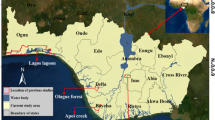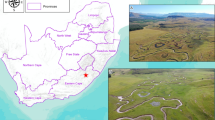Abstract
The important ecosystem functions wetlands perform are influenced by land-use changes in their surrounding uplands and thus, identifying the upland area that flows into a wetland is important. We provide a method to define wetland catchments as the portion of the landscape that flows into a wetland; we allowed catchments to be nested and include other wetlands and their catchments, forming a hydrologic wetland complex. We generated catchments using multiple sources and resolutions of digital elevation data to evaluate whether catchment sizes generated from those data were similar. While non-contributing areas, or sinks, differed between elevation data sets, catchment areas were similar among high-resolution LiDAR- and IfSAR-derived data and readily available lower resolution data from the National Elevation Dataset. Accordingly, the higher-resolution DEM data, which may be expensive or not available, will not likely yield more accurate wetland catchment boundaries in flat or glaciated landscapes. We contend that this method to generate wetland catchments can be used to improve wetland studies where the location of a wetland within a catchment is important. Furthermore, the size of the catchment is important for understanding how wetlands respond to climate, land-use practices, and contamination.




Similar content being viewed by others
References
Anteau MJ (2012) Do interactions of land use and climate affect productivity of waterbirds and prairie-pothole wetlands? Wetlands 32:1–9. doi:10.1007/s13157-011-0206-3
Anteau MJ, Afton AD, Anteau ACE, Moser EB (2011) Fish and land use influence gammarus lacustris and hyalella azteca (Amphipoda) densities in large wetlands across the upper midwest. Hydrobiologia 664:69–80. doi:10.1007/s10750-010-0583-2
Arheimer B, Wittgren HB (2002) Modelling nitrogen removal in potential wetlands at the catchment scale. Ecol Eng 19:63–80. doi:10.1016/S0925-8574(02)00034-4
Arnold JG, Allen PM, Bernhardt G (1993) A comprehensive surface-groundwater flow model. J Hydrol 142:47–69. doi:10.1016/0022-1694(93)90004-S
Bates DM, Maechler M, Bolker BM (2011) lme4: Linear mixed-effects models using S4 classes. R package version 0.999375-42. http://CRAN.R-project.org/package=lme4
Brown MT, Vivas MB (2005) Landscape development intensity index. Environ Monit Assess 101:289–309
Carle MV (2011) Estimating wetland losses and gains in coastal North Carolina: 1994–2001. Wetlands 31:1275–1285. doi:10.1007/s13157-011-0242-z
U.S. Census Bureau (2012) Tiger Roads. http://www.nd.gov/gis/apps/DataDownload/?clipping=Full&coord=ND83-SF&format=SHAPE&layers=NDHUB.ROADS_TIGER
R Development Core Team (2011) R: A language and environment for statistical computing. R foundation for statistical computing, Vienna, Austria. ISBN 3-900051-07-0. http://www.r-project.org/
Dewberry (2010) IFSAR Quality Assurance (QA) report: Intermap’s pilot cell of Alaska USGS. http://ifsar.gina.alaska.edu/data/2010/PROJECT/Delivery201204/Reports/Alaska_IntermapPilot_Cell_11_IfSAR_QCReport_01052011_Final.pdf.
Duke G, Kienzle S (2003) Improving overland flow routing by incorporating ancillary road data into digital elevation models. J Spat Hydrol 3:1–27
ESRI (2010a) ArcGIS v. 10.0. ESRI, Environmental Systems Research Institute, Redlands, CA
ESRI (2010b) Creating a depressionless DEM. http://help.arcgis.com/en/arcgisdesktop/10.0/help/index.html#/Creating_a_depressionless_DEM/009z0000005q000000/.
ESRI (2012a) ArcGIS Model Builder. http://help.arcgis.com/en/arcgisdesktop/10.0/help/index.html#//002w00000001000000.
ESRI (2012b) ArcGIS Resource Center: An overview of the zonal tools. http://help.arcgis.com/en/arcgisdesktop/10.0/help/index.html#/An_overview_of_the_Zonal_tools/009z000000w1000000/.
ESRI, Aquaveo (2013) Arc Hydro Groundwater. http://www.aquaveo.com/software/ahgw-archydro-groundwater-introduction.
Euliss NH, Mushet DM, Wrubleski DA (1999) Wetlands of the prairie pothole region: invertebrate species composition, ecology, and management. In: Batzer DP, Rader RB, Wissinger SA (eds) Invertebrates in freshwater wetlands of North America: ecology and management. Wiley, New York, pp 471–514
Freeman TG (1991) Calculating catchment area with divergent flow based on a regular grid. Comput Geosci 17:413–422
Galatowitsch SM, Whited D, Lehtinen R et al (2000) The vegetation of wet meadows in relation to their land-use. Environ Monit Assess 60:121–144
Gesch D (2007) The National Elevation Dataset. In: Maune D (ed) Digital elevation model technologies and applications: the DEM Users manual, 2nd edn. American Society for Photogrammetry and Remote Sensing, Bethesda, Maryland, pp 99–118
Gleason RA, Euliss NH (1998) Sedimentation of prairie wetlands. Great Plains Res 8:97–112
Gritzner J, Millett BV, Neill MO (2009) Modeling surface-flow characteristics in glaciated landscapes. proceedings of the 2009 ESRI international user conference. ESRI, Environmental Systems Research Institute, p a1221
Harding JS, Benfield EF, Bolstad PV et al (1998) Stream biodiversity: the ghost of land use past. Proc Natl Acad Sci 95:14843–14847
Hayashi M, van der Kamp G, Schmidt R (2003) Focused infiltration of snowmelt water in partially frozen soil under small depressions. J Hydrol 270:214–229. doi:10.1016/S0022-1694(02)00287-1
Hodgson ME, Jensen JR, Schmidt L et al (2003) An evaluation of LIDAR- and IFSAR-derived digital elevation models in leaf-on conditions with USGS Level 1 and Level 2 DEMs. Remote Sens Environ 84:295–308
Houlahan JE, Findlay CS (2003) The effects of adjacent land use on wetland amphibian species richness and community composition. Can J Fish Aquat Sci 60:1078–1094. doi:10.1139/F03-095
Houlahan JE, Findlay CS (2004) Estimating the “critical” distance at which adjacent land-use degrades wetland water and sediment quality. Landsc Ecol 19:677–690
Houlahan JE, Keddy P, Makkay K, Findlay CS (2006) The effects of adjacent land use on wetland species richness and community composition. Wetlands 26:79–96
Intermap (2012a) NEXTMap Americas data sheet. https://www.intermap.com/Portals/0/doc/Brochures/Architecture/NEXTMap Americas Data Sheet.pdf.
Intermap (2012b) NEXTMap Digital Terrain Model. http://www.intermap.com/en-us/databases/nextmap.aspx.
International Water Institute (2012) Red River basin mapping initiative. http://www.iwinst.org/lidar/.
James LA, Watson DG, Hansen WF (2007) Using LiDAR data to map gullies and headwater streams under forest canopy: South Carolina, USA. Catena 71:132–144. doi:10.1016/j.catena.2006.10.010
Jenkins DG, McCauley LA (2006) GIS, SINKS, FILL, and disappearing wetlands. proceedings of the 2006 ACM symposium on applied computing - SAC’06. ACM Press, New York, p 277
Li J, Wong DWS (2010) Effects of DEM sources on hydrologic applications. Comput Environ Urban Syst 34:251–261. doi:10.1016/j.compenvurbsys.2009.11.002
Martz LW, Garbrecht J (1998) The treatment of flat areas and depressions in automated drainage analysis of raster digital elevation models. Hydrogeol J 12:843–855
McCartney M, Cai X, Smakhtin V (2013) Evaluating the Flow Regulating Functions of Natural Ecosystems in the Zambezi River Basin. 59 p.
McCauley LA, Jenkins DG (2005) GIS-based estimates of former and current depressional wetlands in an agricultural landscape. Ecol Appl 15:1199–1208. doi:10.1890/04-0647
McCauley LA, Jenkins DG, Quintana-Ascencio PF (2013a) Isolated wetland loss and degradation over two decades in an increasingly urbanized landscape. Wetlands 33:117–127. doi:10.1007/s13157-012-0357-x
McCauley LA, Jenkins DG, Quintana-Ascencio PF (2013b) Reproductive failure of a long-lived wetland tree in urban lands and managed forests. J Appl Ecol 50:25–33. doi:10.1111/1365-2664.12006
Mitsch WJ, Gosselink JG (2000) Wetlands, 3rd edn. Wiley, New York
Moreno-Mateos D, Comín F, Pedrocchi C, Causapé J (2009) Effect of wetlands on water quality of an agricultural catchment in a semi-arid area under land use transformation. Wetlands 29:1104–1113
Murphy PN, Ogilvie J, Meng F-R, Arp P (2008) Stream network modelling using lidar and photogrammetric digital elevation models : a comparison and field verification. Hydrol Process 22:1747–1754. doi:10.1002/hyp
Norman JM, Houghtalen RJ, Johnston WJ (2001) Hydraulic design of highway culverts, Second Edition. Publication No. FHWA-NHI-01-020. U.S. Department of Transportation, Federal Highway Administration
Poppenga SK, Worstell BB, Stoker JM, Greenlee SK (2010) Using selective drainage methods to extract continuous surface flow from 1-Meter lidar-derived digital elevation data. U.S. Geological Survey Scientific Investigations Report 2010–5059. 12 p
Quinn P (2004) Scale appropriate modelling: representing cause-and-effect relationships in nitrate pollution at the catchment scale for the purpose of catchment scale planning. J Hydrol 291:197–217. doi:10.1016/j.jhydrol.2003.12.040
Remmel TK, Todd KW, Buttle J (2008) A comparison of existing surficial hydrological data layers in a low-relief forested Ontario landscape with those derived from a LiDAR DEM. For Chron 84:850–865
Rieger W (1998) A phenomenon-based approach to upslope contributing area and depressions in DEMs. Hydrol Process 12:857–872
Rubbo MJ, Kiesecker JM (2005) Amphibian breeding distribution in an urbanized landscape. Conserv Biol 19:504–511
Shaw DA, van der Kamp G, Conly FM et al (2012) The fill-spill hydrology of prairie wetland complexes during drought and deluge. Hydrol Process 26:3147–3156. doi:10.1002/hyp.8390
Shaw DA, Pietroniro A, Martz LW (2013) Topographic analysis for the prairie pothole region of Western Canada. Hydrol Process 27:3105–3114. doi:10.1002/hyp.9409
Sloan C (1972) Ground-water hydrology of prairie potholes in North Dakota. Geological Survey Professional Paper 585-C. Washington D.C.
Tiner RW (2003) Geographically isolated wetlands of the United States. Wetlands 23:494–516. doi:10.1672/0277-5212(2003)023[0494:GIWOTU]2.0.CO;2
Tompkins T, Whipps W, Manor L et al (1997) Wetland effects on hydrological and water quality characteristics of a mid- Michigan river system. In: Trettin C, Jurgensen M, Grigal D, Gale M (eds) Northern Forested Wetlands: ecology and management. CRC Press, Boca Raton, pp 273–385
U.S. Department of Agriculture-Natural Resource Conservation Service (2005) Earth Dams and Reservoirs Technical Release 60. 40 p
U.S. Fish and Wildlife Service (2003) National Wetlands Inventory Data. http://www.fws.gov/wetlands
U.S. Geological Survey (2006) National Elevation Dataset. http://ned.usgs.gov/
U.S. Geological Survey (2010) National Hydrography Dataset - 24 k. http://nhd.usgs.gov/
U.S. Geological Survey, U.S. Department of Agriculture-Natural Resource Conservation Service (2009) Federal guidelines, requirements, and procedures for the national Watershed Boundary Dataset: U.S. Geologcal Survey Techniques and Methods 11-A3. 55 p
Verhoeven JTA, Arheimer B, Yin C, Hefting MM (2006) Regional and global concerns over wetlands and water quality. Trends Ecol Evol 21:96–103. doi:10.1016/j.tree.2005.11.015
Wang L, Liu H (2006) An efficient method for identifying and filling surface depressions in digital elevation models for hydrologic analysis and modelling. Int J Geogr Inf Sci 20:193–213. doi:10.1080/13658810500433453
Wang Y, Zheng T (2005) Comparison of light detection and ranging and national elevation dataset digital elevation model on floodplains of North Carolina. Nat Hazards Rev 6:34–40. doi:10.1061/(ASCE)1527-6988(2005) 6
Wang L, Lyons J, Kanehl P, Gatti R (1997) Influences of watershed land use on habitat quality and biotic integrity in Wisconsin streams. Fisheries 22:6–12. doi:10.1577/1548-8446(1997)022<0006
Wechsler SP (2007) Uncertainties associated with digital elevation models for hydrologic applications: a review. Hydrol Earth Syst Sci 11:1481–1500
Winter TC (2003) Hydrological, chemical, and biological characteristics of a prairie pothole wetland complex under highly variable climate conditions: the Cottonwood Lake area, east-central North Dakota. U.S. Geological Survey professional paper 1675. U.S. Geological Survey, Denver, CO
Wright C, Wimberly M (2013) Recent land use change in the Western Corn Belt threatens grasslands and wetlands. Proc Natl Acad Sci 110:4134–4139. doi:10.1073/pnas.1215404110
Acknowledgments
This research was funded by the Plains and Prairie Potholes Landscape Conservation Cooperative and USGS Northern Prairie Wildlife Research Center. We would like to thank Alex Lawton and Peter Mockus for GIS data assistance. Support and advice was provided by Erik Scherff, Wes Newton, Terry Shaffer, Jane Austin, Mark Sherfy, Mark Wiltermuth, and Josh Stafford. The International Water Institute provided LiDAR data and advice on methods. David Ward and Keith Metzger provided assistance in acquiring the IfSAR data. We thank David Jenkins and anonymous reviewers for their comments and improvements to this manuscript. Any use of trade, firm, or product names is for descriptive purposes only and does not imply endorsement by the U.S. Government.
Author information
Authors and Affiliations
Corresponding author
Electronic supplementary material
Below is the link to the electronic supplementary material.
Online Resource 1
Flow chart from Model Builder for the non-contributing areas analysis (PDF 899 kb)
Online Resource 2
Python script for the non-contributing areas analysis (PDF 96 kb)
Online Resource 3
Flow chart from Model Builder for the catchment delineation analysis (PDF 146 kb)
Online Resource 4
Python script for the catchment delineation procedure (PDF 14 kb)
Rights and permissions
About this article
Cite this article
McCauley, L.A., Anteau, M.J. Generating Nested Wetland Catchments with Readily-Available Digital Elevation Data May Improve Evaluations of Land-Use Change on Wetlands. Wetlands 34, 1123–1132 (2014). https://doi.org/10.1007/s13157-014-0571-9
Received:
Accepted:
Published:
Issue Date:
DOI: https://doi.org/10.1007/s13157-014-0571-9




